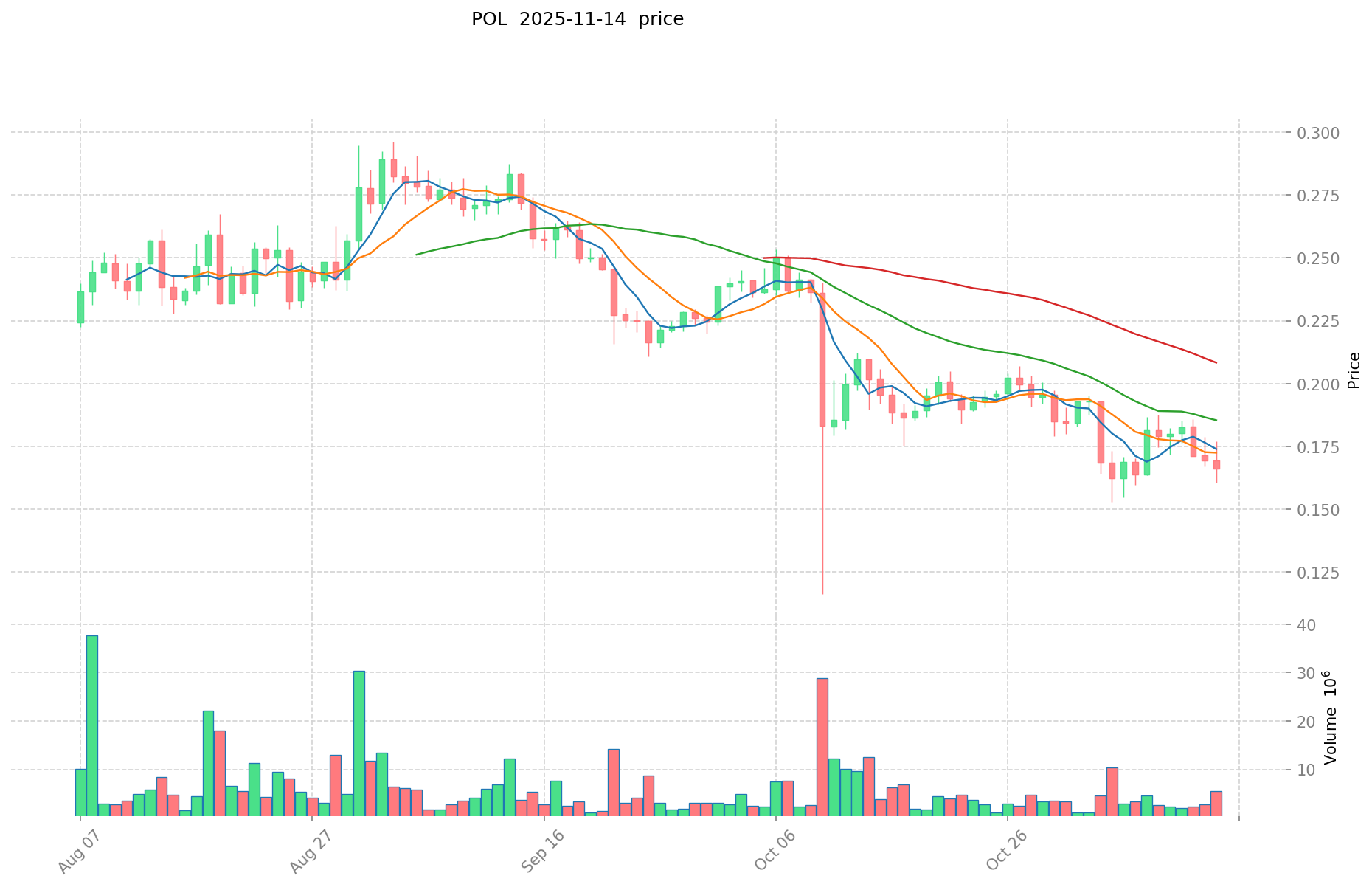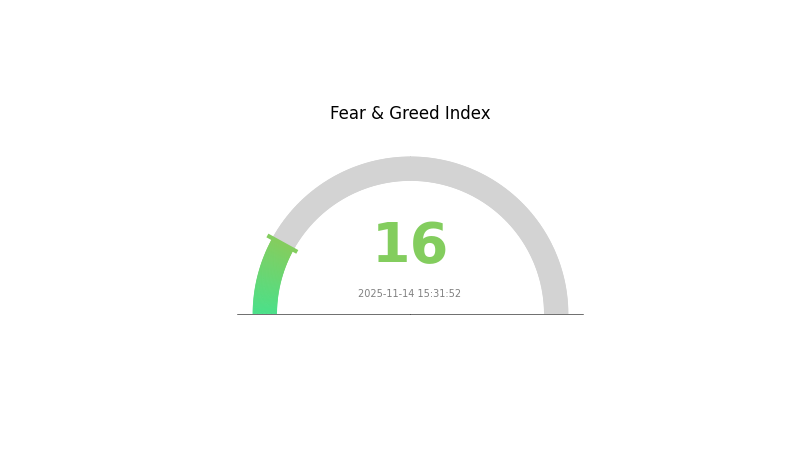2025 POL Price Prediction: Bullish Outlook as DeFi Adoption Accelerates
Introduction: POL's Market Position and Investment Value
Polygon Ecosystem Token (POL), as a key component of the Polygon network's ecosystem, has made significant strides since its inception. As of 2025, POL's market capitalization has reached $1,691,508,352, with a circulating supply of approximately 10,538,992,847 tokens, and a price hovering around $0.1605. This asset, often referred to as the "Ethereum scaling solution," is playing an increasingly crucial role in enhancing blockchain scalability and interoperability.
This article will provide a comprehensive analysis of POL's price trends from 2025 to 2030, considering historical patterns, market supply and demand, ecosystem development, and macroeconomic factors to offer professional price predictions and practical investment strategies for investors.
I. POL Price History Review and Current Market Status
POL Historical Price Evolution Trajectory
- 2023: Launch of Polygon 2.0 protocol, price reached a low of $0.0921
- 2024: Significant milestone with ATH of $1.5711 on April 22
- 2025: Market cycle shift, price dropped from $1.5711 to current $0.1605
POL Current Market Situation
As of November 14, 2025, POL is trading at $0.1605, ranking 63rd in the cryptocurrency market with a market capitalization of $1,691,508,352. The token has experienced a significant decline of 8.43% in the past 24 hours and 57.15% over the past year. The current price is 89.78% below its all-time high of $1.5711, recorded on April 22, 2024. The trading volume in the last 24 hours stands at $1,595,661, indicating moderate market activity. With a circulating supply of 10,538,992,847 POL tokens, the market demonstrates high liquidity. The overall market sentiment is currently in a state of extreme fear, as reflected by the VIX index of 16.
Click to view the current POL market price

POL Market Sentiment Indicator
2025-11-14 Fear and Greed Index: 16 (Extreme Fear)
Click to view the current Fear & Greed Index
The crypto market is gripped by extreme fear, with the Fear and Greed Index plummeting to 16. This level of pessimism often presents potential buying opportunities for long-term investors. However, caution is advised as market volatility may persist. Traders should consider risk management strategies and stay informed about market developments. Remember, market sentiment can shift rapidly, and it's crucial to make informed decisions based on thorough research and analysis.

POL Holdings Distribution
The address holdings distribution data for POL reveals a highly concentrated ownership structure. The top address holds a staggering 69.47% of the total supply, equivalent to 7,318,764.04K POL tokens. This extreme concentration is followed by a significant drop, with the second-largest holder possessing only 4.02% of the supply. The top 5 addresses collectively control 77.36% of all POL tokens, leaving just 22.64% distributed among other holders.
This level of concentration raises concerns about market manipulation and centralization risks. With a single address controlling over two-thirds of the supply, there is potential for significant price volatility if large transfers or sales occur. Moreover, such concentration may undermine the project's decentralization ethos and could impact governance decisions if POL employs a token-based voting system. The current distribution suggests a relatively immature market structure for POL, with limited broad-based adoption and potential barriers to achieving a more balanced token economy in the near term.
Click to view the current POL Holdings Distribution

| Top | Address | Holding Qty | Holding (%) |
|---|---|---|---|
| 1 | 0x0000...001010 | 7318764.04K | 69.47% |
| 2 | 0x4c56...989ff4 | 423916.16K | 4.02% |
| 3 | 0x0d50...df1270 | 222757.39K | 2.11% |
| 4 | 0x79b4...c2cf38 | 108073.13K | 1.03% |
| 5 | 0x7d34...c4777e | 77152.76K | 0.73% |
| - | Others | 2383919.00K | 22.64% |
II. Key Factors Affecting POL's Future Price
Macroeconomic Environment
- Inflation Hedging Properties: As a cryptocurrency, POL may potentially serve as a hedge against inflation, similar to other digital assets. However, its effectiveness as an inflation hedge would depend on various factors including market adoption and overall cryptocurrency market trends.
Technical Development and Ecosystem Building
- Ecosystem Applications: POL likely has some decentralized applications (DApps) or ecosystem projects built on its network, which could contribute to its utility and value. However, specific details about these applications are not provided in the given context.
III. POL Price Prediction for 2025-2030
2025 Outlook
- Conservative prediction: $0.13787 - $0.16
- Neutral prediction: $0.16 - $0.18
- Optimistic prediction: $0.18 - $0.2287 (requires positive market sentiment and project developments)
2026-2027 Outlook
- Market stage expectation: Potential growth phase with increased volatility
- Price range forecast:
- 2026: $0.18959 - $0.21304
- 2027: $0.13685 - $0.25327
- Key catalysts: Project milestones, market adoption, and overall crypto market trends
2028-2030 Long-term Outlook
- Base scenario: $0.22876 - $0.31666 (assuming steady growth and adoption)
- Optimistic scenario: $0.31666 - $0.37482 (assuming strong market performance and project success)
- Transformative scenario: $0.37482 - $0.39265 (assuming breakthrough innovations and widespread adoption)
- 2030-12-31: POL $0.39265 (potential peak based on optimistic projections)
| 年份 | 预测最高价 | 预测平均价格 | 预测最低价 | 涨跌幅 |
|---|---|---|---|---|
| 2025 | 0.2287 | 0.1622 | 0.13787 | 1 |
| 2026 | 0.21304 | 0.19545 | 0.18959 | 21 |
| 2027 | 0.25327 | 0.20425 | 0.13685 | 27 |
| 2028 | 0.28823 | 0.22876 | 0.16242 | 42 |
| 2029 | 0.37482 | 0.25849 | 0.15768 | 61 |
| 2030 | 0.39265 | 0.31666 | 0.25966 | 97 |
IV. POL Professional Investment Strategies and Risk Management
POL Investment Methodology
(1) Long-term Holding Strategy
- Suitable for: Long-term investors and believers in Polygon ecosystem
- Operation suggestions:
- Accumulate POL tokens during market dips
- Participate in Polygon ecosystem projects and staking
- Store tokens in a secure non-custodial wallet
(2) Active Trading Strategy
- Technical analysis tools:
- Moving Averages: Monitor short-term and long-term trends
- Relative Strength Index (RSI): Identify overbought and oversold conditions
- Key points for swing trading:
- Monitor Polygon ecosystem developments and upgrades
- Keep track of overall crypto market sentiment
POL Risk Management Framework
(1) Asset Allocation Principles
- Conservative investors: 1-3% of crypto portfolio
- Aggressive investors: 5-10% of crypto portfolio
- Professional investors: Up to 15% of crypto portfolio
(2) Risk Hedging Solutions
- Diversification: Spread investments across multiple Layer 2 projects
- Stop-loss orders: Set predetermined exit points to limit potential losses
(3) Secure Storage Solutions
- Hot wallet recommendation: Gate web3 Wallet
- Cold storage solution: Hardware wallet for large holdings
- Security precautions: Enable two-factor authentication, use strong passwords
V. Potential Risks and Challenges for POL
POL Market Risks
- High volatility: Cryptocurrency market fluctuations can lead to significant price swings
- Competition: Other Layer 2 solutions may gain market share
- Ethereum upgrades: Changes to Ethereum may impact Polygon's value proposition
POL Regulatory Risks
- Uncertain regulatory landscape: Potential for new regulations affecting Layer 2 solutions
- Cross-border compliance: Varying regulations across jurisdictions may limit adoption
- Taxation changes: Evolving tax laws may impact POL holders
POL Technical Risks
- Smart contract vulnerabilities: Potential for exploits in the Polygon ecosystem
- Scalability challenges: Unforeseen issues in handling increased network load
- Interoperability problems: Difficulties in seamless integration with other blockchains
VI. Conclusion and Action Recommendations
POL Investment Value Assessment
POL presents a compelling long-term value proposition as part of the Polygon ecosystem, which aims to scale Ethereum. However, short-term volatility and competition from other Layer 2 solutions pose significant risks.
POL Investment Recommendations
✅ Beginners: Consider small, long-term positions after thorough research ✅ Experienced investors: Implement dollar-cost averaging strategy and actively participate in the Polygon ecosystem ✅ Institutional investors: Explore strategic partnerships and consider larger allocations based on risk tolerance
POL Trading Participation Methods
- Spot trading: Buy and sell POL on Gate.com
- Staking: Participate in Polygon staking programs for passive income
- DeFi integration: Utilize POL in various DeFi protocols within the Polygon ecosystem
Cryptocurrency investments carry extremely high risk, and this article does not constitute investment advice. Investors should make decisions carefully based on their own risk tolerance and are advised to consult professional financial advisors. Never invest more than you can afford to lose.
FAQ
Will POL reach 1$?
Yes, POL has the potential to reach $1 in the future, given its strong fundamentals and growing adoption in the Web3 ecosystem. However, the exact timeline is uncertain and depends on market conditions.
Is pol coin a good investment?
POL coin shows potential for growth in the Web3 ecosystem. Its innovative features and increasing adoption suggest it could be a promising investment in the crypto market.
What will a Polygon be worth in 2025?
Based on market trends and adoption rates, Polygon (MATIC) could potentially reach $5 to $7 per token by 2025, driven by increased DApp development and Layer 2 scaling solutions.
How high can a pol coin go?
POL could potentially reach $10-$15 by 2026, driven by increased adoption and market growth in the Web3 ecosystem.
Share
Content